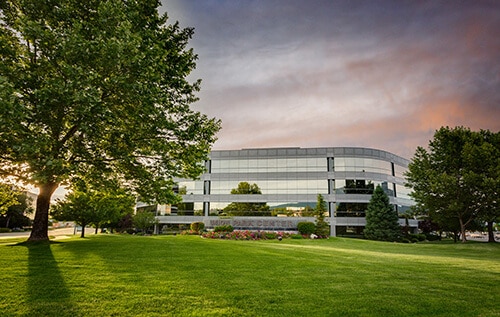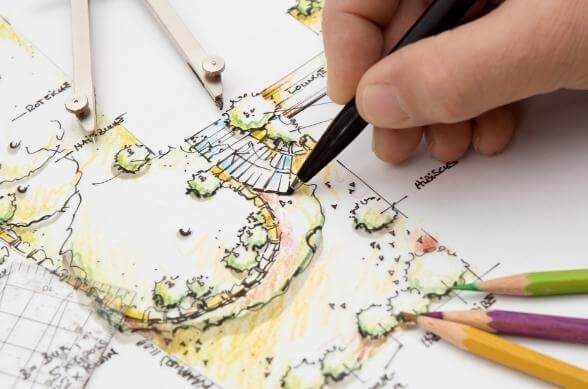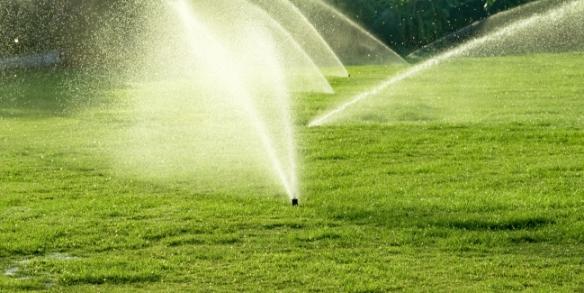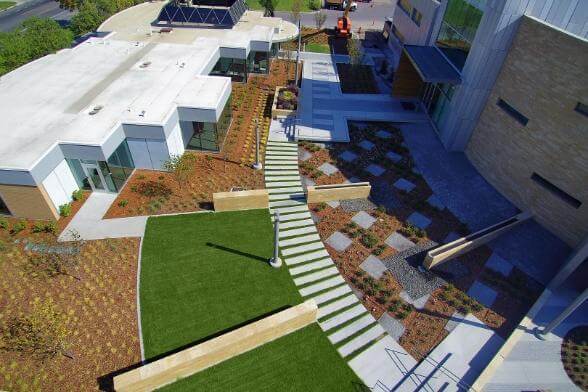Your property’s exterior is a reflection of your company’s vibe. Every business owner wants an attractive landscape, but not everyone knows how to achieve it. Many baulk at the idea of doing their own landscaping, figuring they don’t have the time, the cash, or the expertise for the job. The reality is that commercial landscaping doesn’t have to be complicated or expensive, and doing it yourself ensures that you get exactly what you want out of your projects.
We’ve included this content in our learning center to serve as a detailed guide to landscaping for beginners that will walk you through common landscaping topics and DIY tips. Our hope is that you’ll be able to use this information to make informed decisions, get new landscaping ideas, avoid overspending, and create the perfect outdoor space for your goals and budget.
What is landscaping?
Landscaping is the process of beautifying a piece of land based on a custom design that implements plant growth strategies, improvements, maintenance, and/or the addition of ornamental features, such as flowers, pavers, shrubs, and trees, to achieve a striking aesthetic.
LANDSCAPING VS. LAWN CARE
It’s important to note that landscaping is much broader than just lawn care, which simply involves the care and maintenance of your grass. If you focused solely on lawn care, your landscape would be clean but very one-dimensional, and uninteresting to look at.
While lawn care is an important aspect of landscaping, it’s only one facet; landscaping encompasses all the work that goes into keeping a business exterior pristine and beautiful.
Learn About Lawn CareWhat are the benefits of landscaping?
Whether you’re looking into landscaping to attract new business or just to improve your aesthetic, a well-maintained property can yield a host of benefits, some of which we explain below.
CONSISTENCY OF BUSINESS AESTHETICS
Doing your own landscaping can bring a business owner immense pride and peace of mind. There’s nothing quite like the feeling of putting personal touches on your company and bringing your vision to life. When you tackle this challenge yourself, you can ensure that the design of your interior matches the landscaping of the exterior, for a seamless brand experience that will make your company feel like it’s truly yours.
ENVIRONMENTAL IMPACT
Landscaping has the power to help the environment and save you money. Just by adding a few trees to your business exterior, you can infuse oxygen into the environment while removing dozens of pounds of harmful CO2 from the air annually. Property managers will also love that the cool shade of leafy trees will block the heat of the sun and lower indoor temperatures in the summer; and it keeps warm air in during the winter, by obstructing frosty winds. In turn, you’ll see lower utility bills, less noise pollution, and reduced reliance on appliances to regulate interior temperatures.
What’s more, a strategically designed landscape with a
smart irrigation system can save you water and money on energy bills — enough to pay for itself in just
eight years. Smart commercial irrigation systems keep your lawns green without any effort or worry on your part. That means excellent curb appeal, money savings, and more time to spend managing the other aspects of your property.

RESALE VALUE
If you’re looking to improve your property’s resale value but don’t have the resources to expand or remodel, a landscaping project could be a great solution. When someone is looking to buy retail space, they probably won’t look twice at a property with no external appeal. A beautiful landscape can add significant value to the worth of your commercial property — as much as
20% — and help it sell faster, even if you’ve done the work yourself.
IMPROVES MENTAL AND PHYSICAL HEALTH
As a property manager, providing a beautiful, peaceful commercial landscape for tenants to retreat to is one of the best things you could do for their mental health. A relaxing outdoor atmosphere has a calming and stress-alleviating effect that could make the workplace a happier and more productive place to be. As the one doing the landscape, you could experience this as well in addition to the physical benefits of manual labor.
How to plan for a landscaping project for your budget size
If you try to dive headfirst into a landscaping project without first considering your vision, budget, or goals for aesthetics and functionality, you’re setting yourself up to become overwhelmed. A successful landscaping project requires a strategic, thoughtful approach, and you must know exactly what you want out of it before turning the first sod. Below, we outline the steps to getting started, so you can avoid the headache of wasted resources.
STEP 1: DETERMINE THE SCOPE OF YOUR PROJECT
The best way to over-complicate a landscaping project is to think of it as one large remodel of a commercial space. This usually isn’t needed, and it’s not how professionals approach a project, either. Instead, they work with their clients to evaluate the space and decide if they’re going to add a feature or two, expand what’s already there, or completely redesign the entire space.
If you’re going to completely overhaul your property, the scope of such a project may be too much for you to handle on your own. At this point, you may want to call in a team of contractors. But if you’re going to keep the scope rather limited by expanding what you have or adding a new feature or two, a DIY landscape project is very doable.
For example, maybe you don’t have a lot to spend; you simply want to add flowers, a small fountain, and a few trees. Perhaps you already have broken or mismatched pavers leading up to your main entrance, and just want to extend the pathway and repair the pavers that are there. These projects have a feasible scope that you could easily tackle on your own.
STEP 2: DECIDE WHAT FUNCTIONAL PURPOSE YOUR LANDSCAPING WILL SERVE
Most people who start a landscaping project do so for a reason. For example, maybe they’ve always wanted to plant trees in front of their office windows to block the harsh, direct sunlight in the morning, or improve the view from their conference rooms. Whatever the reason may be for you, having a purpose for your project will guide your efforts.
If you aren’t yet sure what your purpose is, take a moment to consider which features or areas of your property are the most important and how you will build out from them. Maybe you have a flat, grassy area in front of the building on which everyone loves to eat lunch. A space like this has strong potential to be transformed into something more functional. Perhaps there’s a statue or fountain out in the open that you could build out from? Base your design around focal points and elements such as these.

STEP 3: CREATE A BUDGET AND STICK TO IT
Deciding which elements to incorporate in your landscaping project will require some research on your part to make sure your goals are compatible with your budget. Some landscape projects can be done on the cheap, while others may be so costly that a loan is needed. Landscaping doesn’t have to cost an arm and a leg, as long as you know your budget and can stick to it.
Working without a budget when you have limited financial resources can cause your project to quickly grow out of hand. If you aren’t confident in your ability to budget and plan your project accordingly, it might be in your best interest to work with a professional landscape design team.
STEP 4: CONDUCT THE PREPARATION WORK
Every successful project involves some degree of preparation. Small landscape additions, such as small flower beds, don’t require much prior groundwork, but anything larger can necessitate significant planning. We’ve outlined some helpful planning strategies below.

- Draw it out: Having a hard time with your vision? It could help to sketch out a basic landscape blueprint — especially if you’re a visual person. You don’t have to create an artistic masterpiece; simply designate the ways in which you will use your space and how your design elements will work functionally with your building. It can be as simple as designating fences with horizontal lines and trees with upward arrows. Be sure that your design accounts for the seasons and the sunlight; it is a mistake to implement landscaping elements that only look good during one season, or position plant life out of the sun’s reach.
- Make a list: Once you feel good about your budget and blueprint, it’s time to make a list of the supplies you’ll need. Look up the prices of each item from the stores you plan to buy the items from and write these figures down next to each list item. This will ensure that you stay on budget and don’t forget anything. Once your list is complete, you will have an accurate estimate of how much the project will cost you. If your list ends up over budget, you can make adjustments before spending a cent.
- Prepare your space: Depending on your project, you may need to do some preparation work, such as weeding, removing rocks or shrubs, tearing out overgrown vines, or getting rid of an eyesore table. Having a blank, fresh canvas will motivate you and give you a clearer picture in your head of what you want to do with the space.
- Know where to start landscaping: Since you’ll have the most energy and motivation at the beginning of a landscape project, professionals recommend beginning with the heavy-duty work and making your way down to the light work. Get all of the hard work out of the way first, so you can sprint to the finish.
- Understand your limitations: Throughout the process, be realistic about what you can afford and the amount of work you can feasibly accomplish by yourself or as a small group. If you aren’t a professional, there’s no need to hold yourself to the standards of an expert.
What tools do I need to start landscaping?
The tools and materials needed for your landscaping project will depend on what it is you’re doing, but large, expensive equipment is not necessarily needed. However, if you don’t already have the basic tools needed for smaller projects, things can get expensive pretty quickly. Should you plan to buy your own landscaping tools, you can spread out the cost by planning ahead and buying a tool or two every few weeks.
As an alternative, you can also rent landscaping equipment from hardware stores or ask around your neighborhood or social circle to find out if your friends or family members have tools you can borrow.
Here are some of the essentials for landscaping:
- Gloves: You’ll need leather, washable synthetic, and latex-coated cotton gloves for the various tasks that landscapers typically carry out. Leather gloves protect your hands optimally as you dig while latex cotton gloves are ideal for working with wet soil. Washable synthetic gloves are great multipurpose gloves for dry applications.
- Safety equipment: If you’re doing heavy-duty work, protect your eyes, ears, and skin with ear protection, safety glasses, and a long-sleeved shirt. Steel-toed boots may be necessary to protect your feet when working with heavy objects or large equipment.
- Buckets or wheelbarrows: Have plenty of plastic buckets and/or wheelbarrows handy for transporting materials, mixing cement, measuring liquid, cleanup tasks, and more.
- Hand tools: Depending on the job, you’ll likely need common landscaping hand tools such rakes, shovels, hedge trimmers, and pruning shears. These come in various sizes to suit different job sizes.
- Pickup truck: Having a truck can make it immensely easier to carry loads of large landscaping materials from the store or pickup location to your work site. These are available to rent by the hour at hardware stores like The Home Depot if you don’t already own a truck. For smaller-scale jobs, a truck may not be necessary.
- Hose: Most landscaping tasks require water. Be sure to have a constant supply of water at the ready with a garden hose and an adjustable head attachment that has spray sittings for your application.

Why is irrigation important for landscaping?
Having great-looking landscaping means having a reliable irrigation system that protects your vegetation from drought and overwatering in fluctuating weather conditions. A scorching heat wave can quickly turn your grass brown and wilt all of your flowers while excess watering can drown your plant life and contribute to weeds.
To combat this, a
smart irrigation system can detect soil conditions, weather patterns, and changing temperatures and adjust watering schedules accordingly. Once the system is installed, you won’t hardly have to think about it again. Just enjoy an evergreen lawn and all the money savings that come from getting just the right amount of water.
As an added benefit, a smart sprinkler system can alert you of broken water lines so you can correct the damage before your landscape is ever impacted. Make a smart irrigation system from Smart Rain part of your landscape design plan.
Important landscaping tips
OPT FOR LOW-MAINTENANCE LANDSCAPING:
In planning your landscaping project, it’s important to select materials and designs that will be resilient over time and in the elements. This will reduce the amount of time (and money) you spend on maintenance and repairs. Choose low-maintenance plants, durable pavers, and other materials that will retain their beauty long-term with minimal effort on your part.
ENSURE THE SAFETY OF YOUR VISITORS:
Don’t go overboard with intrusive landscaping elements. If you endanger the safety of your patrons, you could face costly litigation. You should choose features that keep walkways clear, level, and well-lit at all times. If you line paths with cobblestone, for example, it may be eye-catching but could also prove to be a trip hazard. If you include water features, place them far away from walkways to minimize a visitor’s risk of falling in. Keep tree- and shrub-lined walkways clear of hazardous branches and vines.
DESIGN A LANDSCAPE THAT ATTRACTS AND ENGAGES PEOPLE:
The exterior of your commercial property will determine whether a person passes it by, or comes in to give you their business. For that reason, be encouraged to be bold with your design elements, and create a warm and welcoming environment that catches the eye and invites people to engage and stay a while. This could mean lining your footpaths with brightly colored flowers, providing shady places to sit enshrouded in greenery, providing fire pits and chairs in the winter, or placing a dazzling rock feature right outside the front door. Whatever you do — aim to make an impression.

DIRECT CUSTOMERS TO THE ENTRANCE:
When people approach your business for the first time, they want to easily be able to find the front entrance. Using functional and beautiful landscape design elements, such as trees, intricate stone pathways, flowers, shrubs, and other visual guides, you can guide people effortlessly to your front door.
CONDUCT SEASONAL LANDSCAPE TOUCH-UPS:
If you want to make sure your landscape looks its best in every season with the changing temperatures, you’ll need to do a little touchup work every three months or so. Seasonal maintenance is the key when it comes to the longevity of your landscaping elements.
IMPLEMENT ENERGY-SAVING FEATURES:
As a busy property manager or business owner, you’re always looking for ways to save time and money. You can make your landscape serve you better by implementing features that yield energy and water savings. This can include the use of a
smart irrigation system, natural design features like trees to insulate your building from harsh weather, and so on.
ENSURE A CONSISTENT WATERING SCHEDULE:
Watering your landscape is one of your most important maintenance tasks. Underwatering or overwatering can have damaging effects on your greenery, so make it a priority to water according to the needs of your vegetation and the current climate. If you want to automate a watering schedule that adjusts with fluctuating soil conditions and seasons, use a smart irrigation system to increase watering precision and reduce effort on your part.
KNOW THE KIND OF MAINTENANCE YOU’RE COMMITTING TO:
As you select the kind of trees, flowers, and plants to include in your landscape design, you need to consider not only how these will look at full maturity but also what level of maintenance will be required to keep up with them. Don’t make the mistake of picking a tree, for example, that grows rapidly and needs constant pruning, or a shrub that constantly drops berries and makes a sticky mess on footpaths. Consult with a professional landscaping team to learn which elements make the best low-maintenance commercial landscape features.
CONSIDER YOUR LAWN AND GARDEN IN THE WINTER:
Many property managers make the mistake of forgetting about their landscaping in the winter and not working on it again until the spring. The winter season gives you time to prepare for what you want your landscaping to look like when the warm weather returns. Take a walk around your property and see if your wood chips will need to be raked out and replaced with fresh ones when spring arrives. Trim your hedges before they bud, so that it grows back in perfect shape in the spring. It’s never too early to get a jump start on your spring landscaping!
Speak with Smart Rain for more landscaping advice
Commercial landscapes make a lasting impression — is your landscape making a positive one? If you’d like more landscaping ideas or tips on achieving a lush, green landscape, Smart Rain is here for you with a host of
smart irrigation solutions that will make your job easier than ever before. Contact us today for an irrigation system evaluation and find out how we can save you time, money, and effort and get you back to your other job responsibilities.







